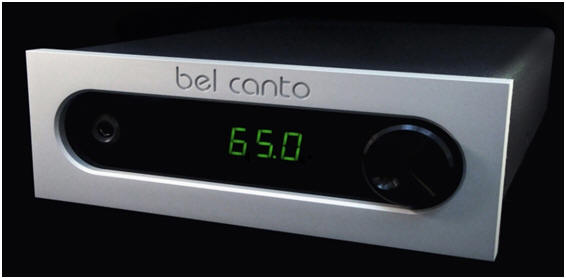|
You are reading the older HTML site
Positive Feedback ISSUE 55
The Neoteric Listener...
the Bel Canto C5i Integrated
Reviewing the Bel Canto C5i DAC integrated amplifier took some arm twisting. No, not me begging some scornful Italian manufacturer for the chance to experience the latest Bel Canto audio opera d'arte. Instead, it was my editor who had to reassure me that, despite the impressive reputation and ritzy Euro name, this do-plenty, plenty-well amplifier is precisely the sort of product that should be evaluated in this column. I'll be the first to admit that I had some trepidation. After all, I had seen the omnipresent Bel Canto name in countless exhibitors' rooms at RMAF and CES events. It was always the chic Bel Canto faceplate in the background powering, clocking, or spinning music, while audio insiders drink Scotch on the sly and whisper that this room "blows doors" on most rooms (always "most rooms" because high-end audio is nothing if not an endless expectation for something better). Anyway, I just assumed that these Bel Canto products were some hand-made, too-good-for-you sonic Bulgari of neo-Renaissance Italia. One "How-do-you-not-know-that?!" look from my editor later, I've since remedied my misconceptions. First of all, Bel Canto is made in Minneapolis (and I didn't even know that was in Italy). Next, the Bel Canto C5i is listed at a pleasantly priced $1895. In theory, if not in money, I could afford it, and because the C5i doesn't put on airs, I don't even have to change into a clean shirt to listen to it. I was more than happy to whisk it away to the shack to pair it with the Nola Contenders on review, my own Nola Boxers, and a pair of Musical Heart Instruments Evidence loudspeakers that I'm babysitting for a friend. Although I played a number of CDs via the Arcam CD82 player and a pair of Stereolab interconnects, the vast majority of listening was straight out of my MacBook Pro to the 24/96 USB input. Using Pure Music, sometimes I utilized the 64 bit upsampling to 96 kHz feature, and at other times I preferred the native sample rate of 44.1 kHz. Either way, the Bel Canto DAC and amp is a quiet, resolving, and nicely warmish sounding integrated that never failed to delight.
I'm no stranger to Class D amps, having reviewed several fine models in the past few years, and it's amazing how different each one sounds. All of the ones I've reviewed share a similar approach in the reproduction of music, however, where speed and responsiveness is aided by an almost inaudibly low noise floor. You don't get the feeling of mass and warmth that you get with a tube amp, although there is frequently an attempt to mimic this quality. As an aside, some people would say that what you don't get is tube bloat, but that's an argument for a different day, and, besides, it's usually a matter of different and not better. I hear you saying, "Well, one sounds better to me, bub," but my experience is that an amp like the Bel Canto sounds just as engaging and musical as the latest flea-watt tube, it's just a matter of which characteristics of audio reproduction you consider to be "music." Personally, that determination requires a house full of gear to be fully satisfied! Moving on, there's no denying the ease of use of the C5i's amp design: compact, cool running, and quiet. It's ready to roll at the press of a rocker switch, and far less of a hassle to set up or move than almost any amp designed for the main room. Living in a house the size of an oversized dumbwaiter, I heartily appreciate an amp compact enough to sit easily in my audio rack. Much as I loved the sound of the Cary SLI 80 and Furutech GT-40 DAC combination, the ground floor platform placement meant the wife and I were doing a harrowing Taoist fire walk to avoid stepping on cables or squashing glowing tubes. The Bel Canto, in contrast, sits nice and polite in its little piece of real estate in the rack, and the amp's large green display is always clearly visible. It's always powered up, because it's stingy on power and heat, and because the manual tells you to keep it on. Who am I to argue with brainy Minnesotans? Belying its affordable price, the C5i retains that characteristic style of all Bel Canto gear, and its solid all-steel chassis is claimed by the manufacturer to prevent "mechanical resonance from compromising the audio signal quality." For less than two grand, you get plenty of high-quality options. Besides the aforementioned USB input, the C5i's digital inputs includes two SPDIF 24/192 and two TOSLINK inputs at 24/192. And the analog MM Phono and Line Level inputs on RCAs ensures that vinyl enthusiasts won't be left out. There's even a headphone jack for the can-can man (or woman) in the family. The C5i's dimensions are 8.5 x 3.5 x 12" (W x H x D) and barely weighs 13 pounds, so you'd think that an audio boardinghouse like this would be a pretty noisy affair. And the fact that it has a switching output stage shouldn't help matters either, but the pure truth is, this amp is as quiet as a bowl of tapioca pudding. If operational noise reduces the clarity and definition of music retrieval, you wouldn't know it by the dead silence and wonderful sonic character of the C5i. Bel Canto's website gives a fairly complete rundown of the technical details of the amp's circuitry, and I'll leave that to those who live for that sort of thing. It's not that I'm too lazy to rehash it, but I don't have the engineering chops to debate whether good sound can be defined by one particular part versus by the overall design. Besides there's an endless stream of forum boards for those into tackling the challenge tower of "this chip sounds the best" or deciding which Ninja discipline is best used to conquer jitter. Although the C5i boasts 115dB dynamic range and proprietary low-noise D-to-A converters, I'm only going on faith when I conjecture that that's why the two Nola speakers and the MHI pair sounded more defined than when paired with the Cary and my own Arcam A80 integrated. Some might call it a more truthful sound, less uncolored, but I'd say that it's more a matter of not having any overt audio tendencies in any direction. But that doesn't mean I didn't try to make the Bel Canto C5i show a meaner side... The MHI pairing proved especially helpful, as these monitors have a laser focus and skew towards being on the sharp side when partnered with the wrong electronics. I figured if any speakers were going to bring out the demons of the Class D dungeon, this is the pair. I connected them to the Bel Canto, put on a digital file of Prince's "I Wanna Be Your Lover," and kept my finger on the mute button. Disaster averted, Will Robinson! Drum machine, Motown-inspired guitar fills with the world's brightest guitar tone, and Prince's trademark falsetto vocals sounded pretty durn good, Anastacia. It sounded better with the Boxers, and best with the Contenders, of course, but the Bel Canto helped to elevate the MHI monitors up a class. Similarly, Prince's "I Wanna be Your Girlfriend" (funny how much better I like his lesser known songs than the big hits) features a great slapback echo hand clap that can easily sound muddy when heard on some systems. Switching back to the Contenders, the contrast between the claps and the popping of the bass guitar strings is a fine mix of percussive and high frequency sounds that benefitted from the C5i's detailed, but never brittle, delivery. An additional recommendation in favor of the C5i is how long I could play it without shutting it off. This may sound like an odd thing to say, but I'm a terrible background music listener. Even when I'm doing something else, I'm noticing some odd rhythm or novel harmony. Consequently, I get pretty cranky when I don't like the music or the sound of the system because I can't tune it out. So when I say that I listened to the Bel Canto from morning cereal to sleepytime tea and was sorry when I had to close down the MacBook that tells me something about how the balance of the C5i's sound appealed to me. Airy, responsive, and enjoyable are all terms that come to mind when playing music with the Bel Canto. Computer files using the USB input retained this same winning sound, although I did slightly prefer CDs played on the Arcam CD82 utilizing a Black Cat digital cable and the Bel Canto's digital input. Just my preference, but I should also confess that most of my everyday listening was with the USB input. Sign of the times… maybe, when even someone who admits they prefer a CD sound still opts for the computer file. But both disc and file sounded great with this integrated, and those who need a headphone amp or phono amp have additional avenues to explore (though I didn't). All in all, the Bel Canto C5i has the combination of looks, sound, function, and price to make it an extremely competitive consumer option. Recommended.
Bel Canto C5i DAC Integrated
Amplifier Bel Canto www.belcantodesign.com
|


